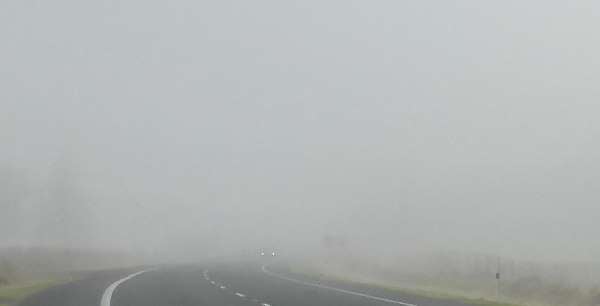The aim of this lesson is for you to drive in poor visibility while making appropriate choices for your speed and position on the road. You’ll need to find 50kph zones at night, in rain, in fog and in sunstrike/glare (obviously not all at the same time).

Driver actions
Driving at night:
- Make sure your windscreen is clean
- Switch your headlights on early if visibility is poor. Your car might have automatic headlights, but you can override this if you feel you need more visibility
- Scan the road at least 12 seconds ahead
- Dip your headlights for other traffic
- Maintain your position to the left of the road
- Check your mirrors every ten seconds or so
- Switch your rear view mirror to anti-dazzle if applicable; some mirrors do this automatically
- Take note of reflectors, guide posts, road studs and street lights to help you determine which way the road goes
Driving in the rain
For more detailed information read our article on driving in low visibility situations here.
- Make sure the windscreen is clean – if it’s drizzle, there might not be enough water to clean the screen straight away and if it’s dirty it could smear, reducing your visibility.
- Turn on your headlights if necessary
- Turn on your windscreen wipers to the appropriate speed, either intermittent, normal or fast. If your vehicle has automatic windscreen wipers it might choose this for you.
- Turn on your demisters if required
- Adjust your speed appropriately and adjust your following distance back to four seconds
- Maintain your position to the left of the road
Driving in fog
For more detailed information read our article on driving in low visibility situations here.
- You need maximum vision in fog, so make sure your windscreen is clean
- Turn your headlights onto dip; full beam creates a large amount of reflection which reduces your visibility
- Turn on your wipers and demisters if necessary
- Adjust your speed so that you can see far enough ahead to stop if necessary; it should be at least four seconds
- Check your mirrors regularly
Driving in sunstrike/glare
For more detailed information read our article on driving in low visibility situations here.
- Keep your windscreen clean – this is particularly important as the dirtier it is, the more light will be refracted on the dirt, affecting your visibility.
- Use the sun visor and sunglasses if you have them
- Adjust your speed and increase your following distance to at least four seconds as you won’t have as good visibility of the road ahead or vehicles’ brake lights
- Keep to the left of the road, or in the centre lane if on a multi-lane road
- Watch out for other vehicles, pedestrians and cyclists
- If the sun is too low and you can’t see, pull over in a safe place on the side of the road until conditions improve. Be aware that if you pull over, other drivers might not see you because of the sunstrike, so ensure you’re off the road.
For more information about driving in poor visibility, check out this article.

